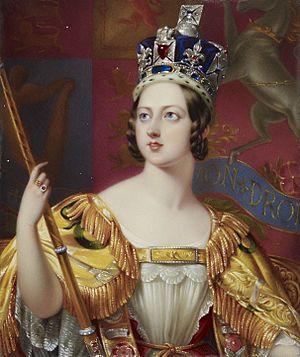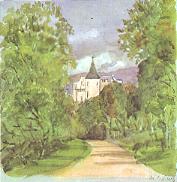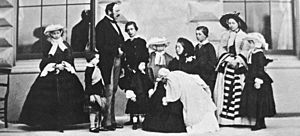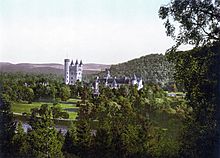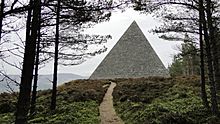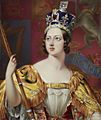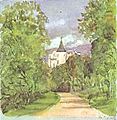Balmoral Castle facts for kids
Quick facts for kids Balmoral Castle |
|
|---|---|
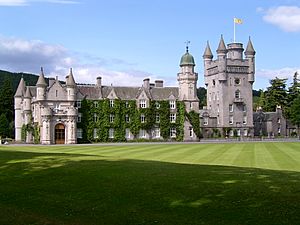 |
|
| Type | Scots baronial mansion |
| Location | Royal Deeside, Aberdeenshire, Scotland |
| Architect | William Smith, directed by Prince Albert |
| Lua error in Module:Location_map at line 420: attempt to index field 'wikibase' (a nil value). | |
Balmoral Castle is a royal residence in Aberdeenshire, Scotland. It was purchased by Prince Albert, Queen Victoria's husband, in 1848. Victoria and Albert paid £30,000 for full ownership of the house in 1852. Queen Victoria laid the foundation stone in 1853, signed a parchment recording the date, and placed it in the hole prepared for the stone. Today, Balmoral is owned privately by the royal family, and is one of Queen Elizabeth II's favourite summer retreats.
Contents
History
King Robert II of Scotland (1316–1390) had a hunting lodge in the area. Historical records also indicate that a house at Balmoral was built by Sir William Drummond in 1390. The estate is recorded in 1451 as "Bouchmorale", and later was tenanted by Alexander Gordon, second son of the 1st Earl of Huntly. A tower house was built on the estate by the Gordons.
In 1662 the estate passed to Charles Farquharson of Inverey, brother of John Farquharson, the "Black Colonel". The Farquharsons were Jacobite sympathisers, and James Farquharson of Balmoral was involved in both the 1715 and 1745 rebellions. He was wounded at the Battle of Falkirk in 1746. The Farquharson estates were forfeit, and passed to the Farquharsons of Auchendryne. In 1798, James Duff, 2nd Earl Fife, acquired Balmoral and leased the castle. Sir Robert Gordon, a younger brother of the 4th Earl of Aberdeen, acquired the lease in 1830. He made major alterations to the original castle at Balmoral, including baronial-style extensions that were designed by John Smith of Aberdeen.
Royal acquisition
Queen Victoria and Prince Albert first visited Scotland in 1842, five years after her accession to the throne and two years after their marriage. During this first visit they stayed at Edinburgh, and at Taymouth Castle in Perthshire, the home of the Marquess of Breadalbane. They returned in 1844 to stay at Blair Castle and, in 1847, when they rented Ardverikie by Loch Laggan. During the latter trip they encountered weather that was extremely rainy, which led Sir James Clark, the queen's physician, to recommend Deeside instead, for its more healthy climate.
Sir Robert Gordon died in 1847 and his lease on Balmoral reverted to Lord Aberdeen. In February 1848 an arrangement was made—that Prince Albert would acquire the remaining part of the lease on Balmoral, together with its furniture and staff—without having seen the property first.
The royal couple arrived for their first visit on 8 September 1848. Victoria found the house "small but pretty", and recorded in her diary that: "All seemed to breathe freedom and peace, and to make one forget the world and its sad turmoils". The surrounding hilly landscape reminded them of Thuringia, Albert's homeland in Germany.
Construction of the new house
The growing family of Victoria and Albert, the need for additional staff, and the quarters required for visiting friends and official visitors such as cabinet members, however, meant that extension of the existing structure would not be sufficient and that a larger house needed to be built.
Construction began during summer 1853, on a site some 100 yards (91 m) northwest of the original building that was considered to have a better vista.
The new house was completed in 1856, and the old castle subsequently was demolished. By autumn 1857, a new bridge across the Dee, designed by Isambard Kingdom Brunel linking Crathie and Balmoral was finished.
Balmoral Castle is built from granite quarried at Invergelder on the estate, It consists of two main blocks, each arranged around a courtyard.
Victoria and Albert at Balmoral
Even before the completion of the new house, the pattern of the life of the royal couple in the Highlands was soon established. Victoria took long walks of up to four hours daily and Albert spent many days hunting deer and game. In 1849, diarist Charles Greville described their life at Balmoral as resembling that of gentry rather than royalty. Victoria began a policy of commissioning artists to record Balmoral, its surroundings, and its staff. Over the years, numerous painters were employed at Balmoral, including Edwin and Charles Landseer, Carl Haag, William Wyld, and William Henry Fisk. The royal couple took great interest in their staff. They established a lending library.
During the 1850s, new plantations were established near the house and exotic conifers were planted on the grounds. Prince Albert had an active role in these improvements, overseeing the design of parterres, the diversion of the main road north of the river via a new bridge, and plans for farm buildings. These buildings included a model dairy that he developed during 1861, the year of his death. The dairy was completed by Victoria. Subsequently, she also built several monuments to her husband on the estate. These include a pyramid-shaped cairn built a year after Albert's death, on top of Craig Lurachain. A large statue of Albert with a dog and a gun by William Theed, was inaugurated on 15 October 1867, the twenty-eighth anniversary of their engagement.
Following Albert's death, Victoria spent increasing periods at Balmoral, staying for as long as four months a year during early summer and autumn. Few further changes were made to the grounds, with the exception of some alterations to mountain paths, the erection of various cairns and monuments, and the addition of some cottages (Karim Cottage and Baile na Coille) built for senior staff. It was during this period that Victoria began to depend on her servant, John Brown. He was a local ghillie from Crathie, who became one of her closest companions during her long mourning.
In 1887, Balmoral Castle was the birthplace of Victoria Eugenie, a granddaughter of Queen Victoria. She was born to Princess Beatrice, the fifth daughter of Victoria and Albert. Victoria Eugenie would become the queen of Spain.
In September 1896, Victoria welcomed Emperor Nicholas II of Russia and Empress Alexandra to Balmoral. Four years later Victoria made her last visit to the estate, three months before her death on 22 January 1901.
After Victoria
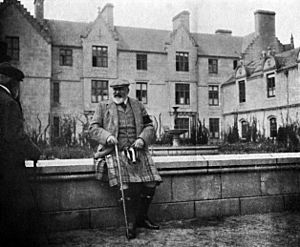
After Victoria's death, the royal family continued to use Balmoral during annual autumn visits. George V had substantial improvements made during the 1910s and 1920s, including formal gardens to the south of the castle.
During the Second World War, royal visits to Balmoral ceased. In addition, due to the enmity with Germany, Danzig Shiel, a lodge built by Victoria in Ballochbuie was renamed Garbh Allt Shiel and the "King of Prussia's Fountain" was removed from the grounds.
In the 1950s, Prince Philip added herbaceous borders and a water garden. During the 1980s new staff buildings were built close to the castle.
Ownership
Balmoral is a private property and, unlike the monarch's official residences, is not the property of the Crown. It originally was purchased personally by Prince Albert, rather than the queen, meaning that no revenues from the estate go to Parliament or to the public purse, as otherwise in accord with the Civil List Act 1760 would be the case for property owned outright by the monarch.
Along with Sandringham House in Norfolk, ownership of Balmoral was inherited by Edward VIII on his accession in 1936. When he abdicated later the same year, however, he retained ownership of them. A financial settlement was devised, under which Balmoral and Sandringham were purchased by Edward's brother and successor to the Crown, George VI.
Currently, the estate is still owned outright by the monarch, but, by Trustees under Deeds of Nomination and Appointment, it is managed by a trust.
The estate
Current extent and operation
Balmoral Estate is within the Cairngorms National Park and is partly within the Deeside and Lochnagar National Scenic Area. The 50,000-acre (20,000 ha) estate contains a wide variety of landscapes, from the Dee river valley to open mountains. There are seven Munros (hills in Scotland over 3,000 feet (910 m)) within the estate, the highest being Lochnagar at 3,789 feet (1,155 m). This mountain was the setting for a children's story, The Old Man of Lochnagar, told originally by Prince Charles to his younger brothers, Andrew and Edward. The story was published in 1980, with royalties accruing to The Prince's Trust. The estate also incorporates the 7,500-acre Delnadamph Lodge estate, bought by Elizabeth II in 1978.
The estate extends to Loch Muick in the southeast where an old boat house and the Royal Bothy (hunting lodge) now named Glas-allt Shiel, built by Victoria, are located.
The working estate includes grouse moors, forestry, and farmland, as well as managed herds of deer, Highland cattle, and ponies. It also offers access to the public for fishing (paid) and hiking during certain seasons.
Approximately 8,000 acres of the estate are covered by trees, with almost 3,000 acres used for forestry that yields nearly 10,000 tonnes of wood per year. Ballochbuie Forest, one of the largest remaining areas of old Caledonian pine growth in Scotland, consists of approximately 3,000 acres. It is managed with only minimal or no intervention. The principal mammal on the estate is the red deer with a population of 2,000 to 2,500 head.
The areas of Lochnagar and Ballochbuie were designated in 1998 by the Secretary of State for Scotland as Special Protection Areas (SPA) under the European Union (EU) Birds Directive. Bird species inhabiting the moorlands include red grouse, black grouse, ptarmigan, and the capercaillie. Ballochbuie also is protected as a Special Area of Conservation by the EU Habitats Directive, as "one of the largest remaining continuous areas of native Caledonian Forest". In addition, there are four sites of special scientific interest on the estate.
The royal family employs approximately 50 full-time and 50–100 part-time staff to maintain the working estate. A malt whisky distillery located on the Balmoral Estate produces the Royal Lochnagar Single Malt whisky.
There are approximately 150 buildings on the estate, including Birkhall, formerly home to Queen Elizabeth The Queen Mother, and used now by Prince Charles and the Duchess of Cornwall for their summer holidays. Craigowan Lodge is used regularly by the family and friends of the royal family and also has been used while Balmoral Castle was being prepared for a royal visit. Six smaller buildings on the estate are let as holiday cottages.
Public access to gardens and castle grounds
In 1931, the castle gardens were opened to the public for the first time and they now are open daily between April and the end of July, after which Queen Elizabeth arrives for her annual stay. The ballroom is the only room in the castle that may be viewed by the public.
Craigowan Lodge
Craigowan Lodge is a seven-bedroom stone house approximately a mile from the main castle in Balmoral. More rustic than the castle, the lodge was often the home of Charles and Diana when they visited. Currently, it is used as quarters for important guests.
In the obituary of Michael Andreevich Romanoff, the highest-ranking member of the Russian imperial family at the time of his death in 2008, it was noted that his family spent most of World War II at Craigowan Lodge.
The lodge has been in the news periodically since 2005, because Queen Elizabeth often spends the first few days of her summer holiday there. During each weekend of the summer the castle is a lucrative source of income from visiting tourists. Sometimes, the Queen arrives at Balmoral before the tourist visiting season is over.
In popular culture
Queen Elizabeth was in residence at Balmoral at the time of the death of Diana, Princess of Wales in 1997. Her private discussions with Prime Minister Tony Blair were dramatised in the Stephen Frears film, The Queen (2006). The 1997 film Mrs. Brown also was based on events at Balmoral. In both films, however, substitute locations were used: Blairquhan Castle in The Queen; and Duns Castle in Mrs Brown.
Banknote illustration
Since 1987 an illustration of the castle has been featured on the reverse side of £100 notes issued by the Royal Bank of Scotland.
Images for kids
-
Balmoral Castle - a principal keep similar to that of Craigievar Castle is the central feature of the castle, while a large turreted country house is attached
-
Edward VII relaxing at Balmoral Castle - photograph by his wife, Alexandra, c. 1907-1908
See also
 In Spanish: Castillo de Balmoral para niños
In Spanish: Castillo de Balmoral para niños



